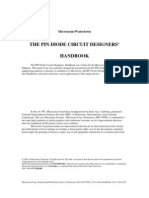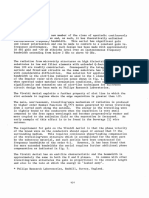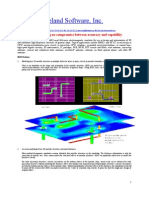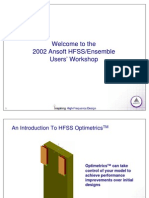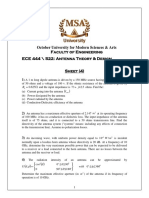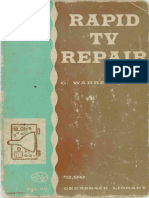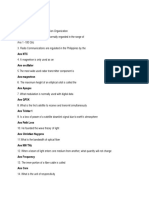Vivaldi Antenna
Vivaldi Antenna
Uploaded by
Ganesh saiCopyright:
Available Formats
Vivaldi Antenna
Vivaldi Antenna
Uploaded by
Ganesh saiCopyright
Available Formats
Share this document
Did you find this document useful?
Is this content inappropriate?
Copyright:
Available Formats
Vivaldi Antenna
Vivaldi Antenna
Uploaded by
Ganesh saiCopyright:
Available Formats
Volume 4, Issue 5, May 2014 ISSN: 2277 128X
International Journal of Advanced Research in
Computer Science and Software Engineering
Research Paper
Available online at: www.ijarcsse.com
Design and Development of a Tapered Slot Vivaldi Antenna
for Ultra-Wide Band Application
N.Vignesh G.A.Sathish Kumar R.Brindha
Second Year M.E Communication System, Professor, ECE Dept. Second Year M.E Communication System,
Sri Venkateswara College of Engg, Sri Venkateswara college of Engg, Sri Venkateswara College of Engg,
Chennai, India Chennai, India Chennai, India
Abstract— Ultra Wideband (UWB) has a number of applications that make it attractive for a variety of applications
such as microwave imaging, wireless communications, ground penetrating radars, remote sensing and phased arrays.
This paper offered the design of a tapered slot Vivaldi antenna for ultra-wideband application using FR4 substrate
which has relative permittivity of 4.4. The Vivaldi Antenna is designed to cover ultra-wideband (UWB) from 3.1 to
10.6 GHz by using CST Software. In order to improve the bandwidth and the return loss characteristics of the emitted
signal, UWB is discovered. The simulation results show that the return loss is better than -10dB within the preferred
frequency range. Therefore the designed antenna will be useful for ultra-wideband application.
Keywords— UWB, Microwave imaging, wireless communications, Ground Penetrating Radar, Remote Sensing,
Phased Arrays, Tapered Slot Vivaldi Antenna.
I. INTRODUCTION
The Vivaldi antenna is the most popular directive antenna for commercial UWB applications due to its simple
structure and small size. The Vivaldi antenna was first introduced by Gibson in “The Vivaldi aerial" [1] which comes
under the Tapered Slot Antenna (TSA) with an exponentially tapered profile etched on a thin metallization [2,3]. Since
then, it is widely used in different applications such as microwave imaging, wireless communications and ground
penetrating radars.
In Vivaldi traveling wave propagate on the inner edges of the flares which is the main mechanism for radiation.
A traveling wave propagating along the surface of the slot with a phase velocity less than the speed of light (i.e., vph ≤ c)
results in an end fire radiation [3]. The dual exponentially tapered slot antenna DETSAs have wider bandwidth and
improved radiation pattern characteristics compared to TSAs.
Figure 1: Tapered Slot Vivaldi Antenna
But the major drawback is typical DETSA dimensions which are generally greater than 10 cm, than those of
other compact UWB antennas [4]. Although Vivaldi antennas have been extensively used in many applications,
especially in ultra-wideband systems [5-8], the original layout has suffered from several design problems mostly related
to poor and inconsistent gain, limited operational bandwidth and large dimensions.
Several design approaches have been proposed in the literature in order to improve the bandwidth, directivity
and to obtain more compact dimensions. These have been recently widely investigated and developed by many
researchers and institutions. A micro strip-to-slot transition adopting a quarter-wave circular slot and a quarter wave
© 2014, IJARCSSE All Rights Reserved Page | 174
Vignesh et al., International Journal of Advanced Research in Computer Science and Software Engineering 4(5),
May - 2014, pp. 174-178
radial strip line stubs was introduced in order to achieve a wider bandwidth than the one obtained with the straight stubs
[9, 10], Vivaldi antenna arrays for see through dry wall and concrete wall UWB applications [11], and miniaturization of
antenna [12-14]. In [13] the traditional micro strip-to-slot line feed transition of a Vivaldi antenna was replaced with a
micro strip-to-parallel strip line. The Antipodal Vivaldi Antenna (AVA) obtained this way overcomes the practical
limitations of a conventional Vivaldi antenna exhibiting a very wide operation bandwidth. However, the antipodal nature
of the antenna gives rise to not only very high levels of cross-polarization, but also severe polarization tilt as the
frequency of operation is increased.
To overcome these problems, by adding another dielectric layer and an extra layer of metallization, the electric
field in the slot region is oriented parallel to the metallization, namely balanced antipodal Vivaldi antenna is formed,
which has smaller cross- polarization level of -15 dB for 6 GHz-18 GHz [11,12]. Recently, several approaches have been
suggested in improving end-fire radiation pattern of balanced Vivaldi antenna, i.e., introducing a dielectric director in
radiation aperture [16].
Various AVA and BAVA designs with more compact size and better radiation properties have been proposed in
the literature [15].Compared to other wideband antennas, the TSAs have moderately high directivity, planer structure,
low profile, and symmetric beam in both E- and H-plane. Also, it is inexpensive to fabricate and easy to integrate. All
those characteristics make the TSA a good candidate for phased array, remote sensing, and short-rage communication.
The aim of this paper was to design an ultra-wideband Vivaldi antenna that was lightweight, compact and conformal,
with approximately constant gain characteristics from 3.1-10.6GHz.
II. VIVALDI ANTENNA DESIGN
The parametric study and design of single element Vivaldi antenna is calculated in three different models:
stripline model, stripline-slotline model and antenna model. Stripline model contains the selection of the substrate
material, substrate thickness and the stripline width. Stripline stub length, slotline stub length, slotline width, antenna
length, antenna width and backwall offset are the factors to be determined in the stripline-slotline model. At last, the
antenna model is built identifying the uniform slotline length, taper length and taper rate, mouth opening and the edge
offset.
As the electrical length of the antenna increases with frequency the gain increases. The length of antenna will
be the addition of taper length, balun length, feed length, backwall offset and width must be equal to λ0, where λ0 is the
free space wavelength at the low frequency. The exponential taper profile is determined by the opening rate and two
points p1(x1, y1) and p2(x2, y2) shown in Figure 1.
The resulting exponential relation explains the taper section
𝒴 = 𝒞1 ℯ ℛ𝒳 + 𝒞2 (1)
Where,
c1, c2 are constants and R the opening rate of the exponential taper. Note that (x1, y1) and (x2, y2) are the
coordinates of the origin and end of flare curve, respectively and the taper length L = x2 - x1. An exponentially tapered
slot line rather than an elliptically antipodal tapering structure was exploited to make the antenna simulation easier.
The selection of a dielectric substrate is one of the most essential features of the design of a Vivaldi antenna.
The important features of a substrate material are its dielectric constant, loss tangent, and the thickness of the dielectric.
The FR4 substrate with a dielectric constant of 4.4 is selected. Effective thickness of the dielectric substrate (teff) need to
be defined as follows [17]
𝑡𝑒𝑓𝑓 𝑡
= ( 𝜀𝑟 − 1) (2)
𝜆𝜊 𝜆𝜊
Where, λ0 is the free space wavelength at the center frequency, t is the thickness and εr is the dielectric constant
of the substrate. The essential criteria for a TSA to possess travelling wave antenna characteristics is [17]
𝑡𝑒𝑓𝑓
0.005 ≤ ≤0.03 (3)
𝜆𝜊
In order to achieve a transition that has low return loss over a wide frequency band, the impedances of the micro
strip line and the slot line must be matched to each other to reduce the reflections. The characteristic impedance of a slot
line increases with increasing slot width, so the width of slot line must be selected to be as small as possible to achieve an
impedance value close to 50Ω. The width, characteristic impedance and guided wavelength of slotline are calculated with
procedures suggested in [18].
The stripline feed used in a Vivaldi antenna is either connected directly to the transmitter/ receiver circuitry or is
fed by a coaxial cable attached to a connector. The stripline width and guided wavelength is calculated using formulas
given in [19]. Hence the antenna parameters calculated are given in Table I.
© 2014, IJARCSSE All Rights Reserved Page | 175
Vignesh et al., International Journal of Advanced Research in Computer Science and Software Engineering 4(5),
May - 2014, pp. 174-178
Table I: Calculated Antenna Parameters All Units are in: mm
PARAMETER FR4 SUBSTRATE
Low Frequency (GHZ) 3.1
High Frequency (GHZ) 10.6
Total Length 123.51
Total Width 96.77
Taper Length 96.77
Taper Width 48.39
Strip Length 5
Strip Width 1.3068
Slot Width 0.4113
Offset of Strip Length 7.38
Backwall Offset 5
Balun Length 7.38
Balun Width 7.38
Substrate Thickness 1.6
III. SIMULATION AND RESULTS
An optimum antenna design is achieved by the adjustment of the following parameters: flare angle and throat
width to reduce the antenna ringing as much as possible.
For the 3.1–10.6 GHz operation, a tapered slot antenna design was developed. The design parameters of the
proposed TSA and the fabricated parts are shown in Figure 1. The manufactured TSA was fabricated on FR4 material
with a relative dielectric constant of 4.4, thickness of 1.6 mm and a loss tangent of 0.025. The top layer shows the
microstrip line used for feeding the tapered slot antenna. The bottom layer indicates the exponential taper profile which is
defined by the opening rate R and it is determined by the first and last point of the antenna.
The validity of the proposed design methodology is verified using CST simulator which is based on finite
differential time domain and method of moments.
Figure 2(a): Front View of Vivaldi antenna
Figure 2(b): Back view of Vivaldi antenna
© 2014, IJARCSSE All Rights Reserved Page | 176
Vignesh et al., International Journal of Advanced Research in Computer Science and Software Engineering 4(5),
May - 2014, pp. 174-178
Figure 3 displays the simulated return loss versus frequency for the Vivaldi antenna. A return loss less than or
equal to -10 dB is acceptable for operation. It is this -10 dB threshold that determines the operational bandwidth. For the
Vivaldi antenna, the operational bandwidth extends from 3.5 GHz to 10.6 GHz and the return loss is above -10 dB.
Figure 3: Simulated Return Loss of Tapered Slot Vivaldi Antenna
By further fine-tuning flare angle and throat width the bandwidth and return loss characteristics can be
improved.
Then figure 4 displays the simulated voltage standing wave ratio (VSWR) versus frequency for the Vivaldi antenna. A
VSWR must be less than 2.1in the specified frequency bands for the acceptable operation of an antenna. For the designed
antenna VSWR is less than 2.1 for the frequency range of 3.5 to 10.6 GHz.
Figure 4: Simulated VSWR of Tapered Slot Vivaldi Antenna
IV. CONCLUSION
In this paper the design of tapered slot antenna for use in ultra-wideband applications has been given. A small
tapered slot Vivaldi antenna is designed on a FR4 substrate with a dimension of 123.51 mm (L) * 96.77 mm (W). The
designed antenna operates across the entire UWB spectrum with few locations that might cause problems if the
dimensions were not precisely tuned. Backwall offset is the extra metallization fixed at the opening of the slotline. An
increase or decrease in the backwall offset parameter result in abrupt changes in the return loss characteristics of the
antenna. But the above condition is true only for certain values of backwall offset parameter. Antenna length must be
greater than a free space wavelength at the lowest frequency of operation. This condition assures equally well gain and
beamwidth performance.
The width of an antenna must be greater than the half wavelength. Any change in width results a change in the
bandwidth of an antenna. Also the width controls the lower frequency of operation.
ACKNOWLEDGMENT
I express my heartfelt thanks to my supervisor Dr.G.A.Sathish Kumar, professor, Department of Electronics and
Communication Engineering, Sri Venkateswara College of Engineering, for his immense and timely help given during
this project work. I also thank our entire department faculty members and friends for their valuable suggestions and
support.
REFERENCES
[1] P.J. Gibson. “The Vivaldi aerial.” Proceedings of the 9th European Microwave Conference, pages 101–105, 1979.
[2] Gazit.E. “Improved Design of the Vivaldi Antenna.” Proc.IEE,1988,135H,pp.89-90.
© 2014, IJARCSSE All Rights Reserved Page | 177
Vignesh et al., International Journal of Advanced Research in Computer Science and Software Engineering 4(5),
May - 2014, pp. 174-178
[3] Oraizi, H. and S. Jam, “Optimum design of tapered slot antenna profile," IEEE Trans. on Antennas and Propag.,
Vol. 51, No. 8,1987-1995, 2003.
[4] M. C. Greenberg, K. L.Virga, and C. L. Hammond, “Performance characteristics of the dual exponentially tapered
slot antenna (DETSA) for wireless communications applications,” IEEE Trans. Veh. Technol, vol.52, no. 2, pp.
305–312, Mar. 2003.
[5] Mehdipour, A., K. Mohammadpour-Aghdam, and R. Faraji-Dana,”Complete dispersion analysis of Vivaldi
antenna for ultra-wideband applications." Progress In Electromagnetics Research,Vol. 77, 85-96, 2007.
[6] Yang, Y., Y. Wang, and A. E. Fathy, “Design of compact Vivaldi antenna arrays for UWB see through wall
applications," Progress In Electromagnetics Research, Vol. 82, 401-418, 2008.
[7] Vu, T. A., et al., “UWB Vivaldi antenna for impulse radio beamforming," Proc. of the 2009 NORCHIP, 1-5, Nov.
2009.
[8] Ruvio, G., “UWB breast cancer detection with numerical phantom and Vivaldi antenna," Proc. of the 2011 IEEE
International Conference on Ultra-wideband (ICUWB), 8-11,Bologna, Italy, Sep. 2011.
[9] Schuppert, B., “Microstrip/slotline transitions: Modeling and experimental investigations," IEEE Trans. on
Antennas and Propag., Vol. 36, No. 8, 1272-1282, 1988.
[10] Zinieris, M. M., R. Sloan, and L. E. Davis, “A broadband microstrip-to-slotline transition," Microwave and
Optical Technology Letters, Vol. 18, No. 5, 339-342, 1998.
[11] Y. Yang, Y. Wang, and A. E. Fathy, “Design of Compact Vivaldi Antenna Arrays for UWB SeeThrough Wall
Applications,” Progress In Electromagnetics Research, PIER 82, 401–418, 2008.
[12] Hood, A. Z., T. Karacolak, and E. Topsakal, “A small antipodal Vivaldi antenna for ultrawide-band applications,"
IEEE Antenna Wireless Propag. Lett., Vol. 7, 656-660, 2008.
[13] Jolani, F., G. R. Dadashzadeh, M. Naser-Moghadasi, and A. M. Dadgarpour, \Design and optimization of compact
balanced antipodal Vivaldi antenna," Progress In Electromagnetics Research C, Vol. 9, 183-192, 2009.
[14] Fei, P., Y.-C. Jiao, W. Hu, and F.-S. Zhang, “A miniaturized antipodal Vivaldi antenna with improved radiation
characteristics," IEEE Antenna Wireless Propag. Lett., Vol. 10, 127-130, 2011.
[15] Hood, A. Z., T. Karacolak, and E. Topsakal, “A small antipodal Vivaldi antenna for ultrawide-band applications,"
IEEE Antenna Wireless Propag. Lett., Vol. 7, 656-660, 2008.
[16] Bourqui, J., M. Okoniewski, and E. C. Fear, “Balanced antipodal Vivaldi antenna with dielectric director for near-
field microwave imaging," IEEE Trans. Antennas Propag., Vol. 58, No. 7, 2318-2326, Jul. 2010.
[17] Johnson, Richard C “Antenna Engineering Handbook”, 3rd Edition, McGraw-Hill.: 1993.
[18] R. Janaswam, Student Member, D.H. Schaubert, Senior Member “Characteristic Impedance of a Wide Slot Line
on Low Permittivity Substrates” Department of Electrical and Computer Engineering University of Massachusetts
Amherst, MA 01003.
[19] David M Pozar, “Microwave Engineering”, 3rd Edition, John Wiley & Sons: 2008.
© 2014, IJARCSSE All Rights Reserved Page | 178
You might also like
- Kuchar - Aperture Coupled Micro Strip Patch Antenna Array - 1996Document91 pagesKuchar - Aperture Coupled Micro Strip Patch Antenna Array - 1996charitebNo ratings yet
- Joveria Raja (BCS-068 (6B) ) Lab 6Document20 pagesJoveria Raja (BCS-068 (6B) ) Lab 6kainat ahmadNo ratings yet
- Reflector Antenna System DesignDocument35 pagesReflector Antenna System DesignAyyem Pillai VNo ratings yet
- Near Field Antenna MeasurementDocument44 pagesNear Field Antenna MeasurementM ANo ratings yet
- 8.5" Portable Handheld TV User Manual: Español EnglishDocument43 pages8.5" Portable Handheld TV User Manual: Español EnglishJesseNo ratings yet
- Design of Pyramidal Horn Antenna For UWB ApplicationsDocument3 pagesDesign of Pyramidal Horn Antenna For UWB ApplicationsAmador Garcia IIINo ratings yet
- To College DESIGN OF TAPER SLOT ARRAY FOR ULTRA WIDE Review 1.1Document24 pagesTo College DESIGN OF TAPER SLOT ARRAY FOR ULTRA WIDE Review 1.1Subburam SrinivasanNo ratings yet
- Optical and Microwave Technologies for Telecommunication NetworksFrom EverandOptical and Microwave Technologies for Telecommunication NetworksNo ratings yet
- Horn AntennaDocument6 pagesHorn Antennanaji1365No ratings yet
- AG312 Pin Diode PDFDocument18 pagesAG312 Pin Diode PDFtuwinnerNo ratings yet
- P-I-N Diode HandbookDocument137 pagesP-I-N Diode HandbookChangjian LiNo ratings yet
- HFSS Floquet PortsDocument44 pagesHFSS Floquet PortsKenny PhamNo ratings yet
- Antenna Design For UWB Radar Detection Application: Sohaib MaalikDocument42 pagesAntenna Design For UWB Radar Detection Application: Sohaib MaalikSaif KamalNo ratings yet
- Brochure EM3DS 12Document2 pagesBrochure EM3DS 12dmfa061No ratings yet
- FEKO. Script ExamplesDocument182 pagesFEKO. Script ExamplesLaz GsodfjxNo ratings yet
- 2575 Circuitpro 1 5 Manual Version 1 0 EnglishDocument111 pages2575 Circuitpro 1 5 Manual Version 1 0 EnglishVictor Guachimbosa SantiagoNo ratings yet
- 570914000AntennaArray CST MWS - SimulationDocument9 pages570914000AntennaArray CST MWS - SimulationkaranNo ratings yet
- MultibandDocument27 pagesMultibandSandhyaNo ratings yet
- The Vivaldi Aerial - P.J.gibsonDocument5 pagesThe Vivaldi Aerial - P.J.gibsonIsmael Roberto Acevedo PavezNo ratings yet
- 2.design of Vivaldi Antennas ThesisDocument83 pages2.design of Vivaldi Antennas ThesisAlteea MareNo ratings yet
- Bandwidth Enhancement of Microstrip Patch AntennaDocument5 pagesBandwidth Enhancement of Microstrip Patch AntennaSwapnil ThoratNo ratings yet
- Aperture AntennaDocument24 pagesAperture AntennamuseNo ratings yet
- Microstrip Patch AntennaDocument74 pagesMicrostrip Patch AntennaNasiruzzaman NahidNo ratings yet
- CST n55-Slvp28nd ManualDocument48 pagesCST n55-Slvp28nd ManualRicardo NovondoNo ratings yet
- Antennas PDFDocument2 pagesAntennas PDFwaytelaNo ratings yet
- Lab Manual OF Antenna and Wave Propagation: Using MATLABDocument83 pagesLab Manual OF Antenna and Wave Propagation: Using MATLABSting GonsalisNo ratings yet
- Low Frequency Electro Magnetic Design and Simulation: CST em StudioDocument2 pagesLow Frequency Electro Magnetic Design and Simulation: CST em StudioTotostyle AmrNo ratings yet
- Improved Design of The Vivaldi Antenna - E.gazutDocument4 pagesImproved Design of The Vivaldi Antenna - E.gazutIsmael Roberto Acevedo PavezNo ratings yet
- Customized Post Processing Using The Result Template ConceptDocument13 pagesCustomized Post Processing Using The Result Template ConceptshochstNo ratings yet
- EE426 LabMan Exp1 7 Spr2013-1Document62 pagesEE426 LabMan Exp1 7 Spr2013-1Serkan KaradağNo ratings yet
- CST Application Note Designing Phased Array AntennaDocument6 pagesCST Application Note Designing Phased Array AntennaMertKarahanNo ratings yet
- Questionnaires Antennas CH 1 & 2Document5 pagesQuestionnaires Antennas CH 1 & 2Joshua CarrionNo ratings yet
- 2.microwave Engineering PDFDocument82 pages2.microwave Engineering PDFsankeerthanreddyNo ratings yet
- Antenna MeasurementsDocument6 pagesAntenna MeasurementsrajasekarkprNo ratings yet
- Design and Simulation of Rectangular Microstrip Patch Antenna With Triple Slot For X BandDocument10 pagesDesign and Simulation of Rectangular Microstrip Patch Antenna With Triple Slot For X BandIJRASETPublicationsNo ratings yet
- Double Band A' Shape Slotted Microstrip Patch Antenna For Wireless CommunicationDocument28 pagesDouble Band A' Shape Slotted Microstrip Patch Antenna For Wireless CommunicationAnkit Mayur100% (1)
- Captured Power It Is The Power Available at The AntennaDocument2 pagesCaptured Power It Is The Power Available at The AntennaADSRNo ratings yet
- Waveguide ChartDocument3 pagesWaveguide ChartHumbertoNo ratings yet
- Photonic Crystal Cavities: Nanophotonics and Integrated OpticsDocument8 pagesPhotonic Crystal Cavities: Nanophotonics and Integrated OpticsMax Marcano CamposNo ratings yet
- 4 1 2 Uwb Antenne Simulation With CST Microwave StudioDocument24 pages4 1 2 Uwb Antenne Simulation With CST Microwave StudioUmair SaleemNo ratings yet
- Substrate Integrated Waveguide (SIW) Techniques: The State-of-the-Art Developments and Future TrendsDocument23 pagesSubstrate Integrated Waveguide (SIW) Techniques: The State-of-the-Art Developments and Future TrendsclanonNo ratings yet
- AntennasDocument35 pagesAntennasRakesh KumarNo ratings yet
- RF Guideline Propagation Model TuningDocument57 pagesRF Guideline Propagation Model Tuningaqua_salmanNo ratings yet
- Ie3d FeaturesDocument5 pagesIe3d Featuresvishnuu06No ratings yet
- A New Planar Marchand BalunDocument4 pagesA New Planar Marchand BalunCARROUCHO62No ratings yet
- An Introduction To HFSS OptimetricsDocument52 pagesAn Introduction To HFSS OptimetricsdhruvaaaaaNo ratings yet
- ECE584 Lab Manual PDFDocument33 pagesECE584 Lab Manual PDFRam PrasadNo ratings yet
- Ridged Horn AntennaDocument4 pagesRidged Horn AntennachmscemNo ratings yet
- EDICONChina2019 - (87) - Vye, David - Designing A Narrowband 28-GHz Bandpass Filter For 5G Applications PDFDocument41 pagesEDICONChina2019 - (87) - Vye, David - Designing A Narrowband 28-GHz Bandpass Filter For 5G Applications PDFkhyatichavdaNo ratings yet
- Sheet 4Document2 pagesSheet 4Toka AliNo ratings yet
- Cell Phone Antenna REPORTDocument12 pagesCell Phone Antenna REPORTnikita kumariNo ratings yet
- Microwave Filters for Communication Systems: Fundamentals, Design, and ApplicationsFrom EverandMicrowave Filters for Communication Systems: Fundamentals, Design, and ApplicationsNo ratings yet
- Design and Application of Vivaldi Antenna ArrayDocument10 pagesDesign and Application of Vivaldi Antenna ArrayVinh CamNo ratings yet
- An Approach To Design and Optimization of WLAN Patch Antennas For Wi-Fi ApplicationsDocument6 pagesAn Approach To Design and Optimization of WLAN Patch Antennas For Wi-Fi Applicationsvietnguyen_93No ratings yet
- Vivaldi Antenna With Pattern Diversity For 0.7 To 2.7 GHZ Cellular Band ApplicationsDocument4 pagesVivaldi Antenna With Pattern Diversity For 0.7 To 2.7 GHZ Cellular Band ApplicationsAsit PandaNo ratings yet
- Review Paper For Circular Microstrip Patch Antenna: ISSN 2249-6343Document4 pagesReview Paper For Circular Microstrip Patch Antenna: ISSN 2249-6343Tri AdiNo ratings yet
- Design of A Compact Circular Microstrip Patch Antenna For Wlan ApplicationsDocument11 pagesDesign of A Compact Circular Microstrip Patch Antenna For Wlan ApplicationsijansjournalNo ratings yet
- Hexagon Microstrip Antenna For Vehicle To Vehicle CommunicationDocument6 pagesHexagon Microstrip Antenna For Vehicle To Vehicle CommunicationBryan Gaibor AmbiNo ratings yet
- Bandwidth Enhancement of Substrate Integrated Waveguide CavityDocument9 pagesBandwidth Enhancement of Substrate Integrated Waveguide CavitybluewolfNo ratings yet
- Review Paper For Circular Microstrip Patch Antenna: ISSN 2249-6343Document4 pagesReview Paper For Circular Microstrip Patch Antenna: ISSN 2249-6343Charan Macharla'sNo ratings yet
- BandwidthDocument5 pagesBandwidthAndrade Sosa Tarek HiramNo ratings yet
- Wireless Data Transmission Cum Data Acquisition Through IOT in Industrial EnvironmentDocument7 pagesWireless Data Transmission Cum Data Acquisition Through IOT in Industrial EnvironmentkhozainuzNo ratings yet
- Telecom RevolutionDocument22 pagesTelecom RevolutionAvinash SinghNo ratings yet
- Gernsback's Educational Library 60 Rapid TV RepairDocument228 pagesGernsback's Educational Library 60 Rapid TV RepairWillian LopesNo ratings yet
- Manual FfmpegDocument298 pagesManual Ffmpeguno_wosNo ratings yet
- SI Daily Traffic Recharge ReportAug 01-12-2021Document88 pagesSI Daily Traffic Recharge ReportAug 01-12-2021Lindon ManehetaNo ratings yet
- User - Manual Panasonic TDE6600Document266 pagesUser - Manual Panasonic TDE6600GABRIEL GONZALEZNo ratings yet
- Hamradio - International Naval ContestDocument12 pagesHamradio - International Naval ContestAntal100% (1)
- EVK1000 Product BriefDocument9 pagesEVK1000 Product BriefJan KubalaNo ratings yet
- Sony Kdl-32ex525 Kdl-40ex525 Chassis Az2-F Rev.1 SM PDFDocument56 pagesSony Kdl-32ex525 Kdl-40ex525 Chassis Az2-F Rev.1 SM PDFRicardo SilvaNo ratings yet
- Dhi Nvr1104hs P s3 HDocument2 pagesDhi Nvr1104hs P s3 HItalo Vicente Luis Ferrara BastardoNo ratings yet
- Digital Satellite News GatheringDocument5 pagesDigital Satellite News GatheringHabtamu TadesseNo ratings yet
- Microprocessor & Computer Architecture (Μpca) : I/O And Bus ArchitectureDocument28 pagesMicroprocessor & Computer Architecture (Μpca) : I/O And Bus ArchitecturePranathi PraveenNo ratings yet
- Uccx - B - 125getting Started Ip IvrDocument110 pagesUccx - B - 125getting Started Ip IvrMohamed LyNo ratings yet
- Very Small Aperture Terminals: A Seminar ReportDocument31 pagesVery Small Aperture Terminals: A Seminar ReportDeepak RawatNo ratings yet
- Hall 5e TB Ch12Document12 pagesHall 5e TB Ch12Patricia Ann GuetaNo ratings yet
- NWEG5111 Ta 2019Document6 pagesNWEG5111 Ta 2019muhammed shaheed IsaacsNo ratings yet
- Case Study: Routing & Switching: Connecting NetworksDocument12 pagesCase Study: Routing & Switching: Connecting NetworksWail ChoukhairiNo ratings yet
- Konference Kubernetes Ii.: Openshift SDN Jan Dvořák Praha 24.9.2019Document56 pagesKonference Kubernetes Ii.: Openshift SDN Jan Dvořák Praha 24.9.2019lythosNo ratings yet
- TI Space Products GuideDocument39 pagesTI Space Products GuideYze Shiuan YNo ratings yet
- Tau (Noise) STD Deviation 0.001 Mean 0Document16 pagesTau (Noise) STD Deviation 0.001 Mean 0RAVINDRA KUMARNo ratings yet
- QuizDocument14 pagesQuizSethbaldovinoNo ratings yet
- The Fastest The Most ComplexDocument2 pagesThe Fastest The Most ComplexDiHLoSNo ratings yet
- INP-014180-ENT-017-SITE ACCEPTANCE TEST PROCEDURE-Rev04Document11 pagesINP-014180-ENT-017-SITE ACCEPTANCE TEST PROCEDURE-Rev04Arunkumar ParthasarathyNo ratings yet
- Mongolia Ictict MongoliaDocument23 pagesMongolia Ictict MongoliaSbr Nyak NyakNo ratings yet
- CCNA Exp2 - Chapter10 - Link-State Routing ProtocolDocument28 pagesCCNA Exp2 - Chapter10 - Link-State Routing Protocolhttp://heiserz.com/No ratings yet
- Flip FlopsDocument3 pagesFlip FlopsMusic LifeNo ratings yet
- Question Paper Code:: Reg. No.Document2 pagesQuestion Paper Code:: Reg. No.rajkumarsacNo ratings yet
- Wireless Access Point Repeater / Bridge / 4-Port Switch: AirtiesDocument3 pagesWireless Access Point Repeater / Bridge / 4-Port Switch: Airtiesvagus2No ratings yet











